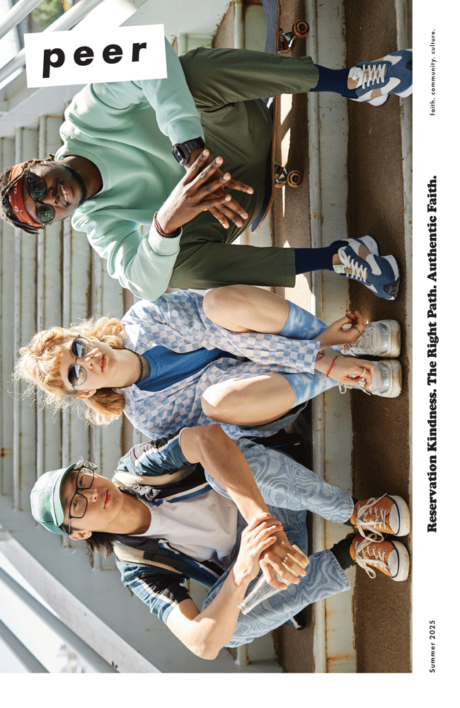
Befriending Imperfection
Let “Barbie” illustrate three principles for enriching how we relate to our flesh and bone.What comes to mind when you think of Barbie? Smooth skin? Long legs? Voluminous blonde hair? Raking in more than $500 million globally in the week of its release, the box office success of the movie “Barbie” demonstrates our fascination with the doll. Perhaps Barbie occupies the collective imagination because she unexpectedly offers lessons on the human experience that span generations and time zones.
Between scenes of plastic and pink, the movie “Barbie” illustrates truths on God’s design for humanity that often go overlooked in a digital age. Barbie, like us, must confront the myth of perfection to embrace the fullness of our humanity—body and soul.
As it turns out, someone traded a land of perfection for the limitations of life on earth well before the famous doll. And as creatures made in the image of God and endowed with inherent dignity, our design surpasses the accidental. Human embodiment appears on the first pages of the Bible. God breathes life into mankind, forming them from dust (Genesis 2:7). Our bodies matter because they are given by God. He knits us together (Psalm 139:13-16). He knows our thirst, hunger and every need in between (Matthew 6:31-32). Yet learning to live within God’s design instead of fighting against it often comes with difficulty.
Embodied living, the practice of making peace with our bodies through recognition and connection, frees us to embrace the whole of our humanity. Not sure where to start? Let “Barbie” illustrate three applicable principles for enriching how we relate to our flesh and bone.
3 Practices for Embodied Living
1. Honor emotional discomfort.
“Do you guys ever think about dying?” Barbie blurts out this question mid-choreography during her Dreamhouse dance party extravaganza. Everything screeches to a halt. Why point out the painful truth? Yet Barbie’s willingness to embrace emotional discomfort serves a purpose, catapulting her on a journey of discovery, growth and ultimately, joy. Could the same ring true for us as we approach our emotions with curiosity and respect?
Acting as signposts that indicate needs, desires and values, emotions manifest physically in the body. Acknowledging negative realities, whether thoughts of death, financial anxiety or just plain FOMO (fear of missing out), often introduces the first step toward wholeness. Suppressing, numbing and outright ignoring emotional discomfort leaves us fragmented. Making space for less-than-chipper feelings and naming them offers a way to work with, rather than against, our design as emotive creatures.
Far from teaching us to stuff our emotions down, Scripture provides a framework for the healthy expression of emotion. The book of Psalms serves as a peek behind the curtain, a glimpse at candid prayers that cover the range of human experiences. Mad at God? Explore the honesty in Psalm 22. So ecstatic you might explode? Echo the praises of Palm 63:5-9. Wrestling with fear? Let the words of Psalm 27:1-5 wash over your worries. The Psalms assure us that we can bring it all—lament and praise—to the One who already knows our hearts.
2. Embrace physical limits.
We anticipated the fabulous pink costumes. We expected the surreal set design. What dropped our jaw in shock? The movie’s predominant theme: mortality.
Unlike durable plastic dolls, humans exist as finite creatures, a fact the multitudes mask with antiaging creams, green juice and Botox injections. We fight against our finitude, preferring the unchanging perfection of Barbie to the aging, aches and limitations of the human experience. Why? For many, the fight against time stems from a desire to control our appearance and well-being. We long to act as the Creator, calling the shots, rather than the created, subject to gravity, wrinkles and seasonal allergies.
After a first-time encounter with bad breath and cellulite, Barbie seeks wise counsel. To remedy her ailments, Barbie discovers she must decide between stilettoes and sandals. Each pair of shoes stands in as a symbol for the choice to stay in Barbieland or journey to the perilous real world. Listening to her body’s changes, Barbie ultimately opts to launch into an adventure of purpose.
Similarly, when we go the way of the proverbial sandals by listening to our body’s cues for nourishment, rest and connection, we discover that limits don’t only constrain. They can also set free. Rather than issues to solve, they can serve as borders to live fully within as limits can bring freedom. Embracing limits can help us loosen the chains that keep us bound to unrealistic self-expectations and the futile fight against the clock. We can’t do it all in 24 hours. As soon as one box gets checked off the to-do list, another appears. Only by recognizing our limits can we say “no” to the rat race and “yes” to rest, discovering something beautiful along the way.
Jesus grew weary. Before his life-altering conversation with the Samaritan woman, John 4:6 tells us that Jesus was tired from his journey. The King of the Universe had to rest his feet, had to pause for water out of thirst and exhaustion. Jesus, the fullness of what it means to be human, experienced the limitations of finitude firsthand (Philippians 2:7). As a result, the Incarnate Son both brings dignity to our own limits and extends help in our weakness (Hebrews 4:14-16).
3. Celebrate the beauty in humanity.
In the iconic bench scene that the director, Greta Gerwig, refers to as “the heart of the movie,” Barbie finds herself sharing a bench with an elderly woman. Looking out on a park, Barbie observes a father pushing his pig-tailed daughter on a bike, sees a young couple arguing during a picnic date, and hears the laugh of friends as they stroll arm in arm.
Barbie turns to the woman beside her and is overwhelmed by the depth of the human experience that she beholds. She recognizes in the woman a new kind of beauty, not superficial, but rich with maturity and meaning. In this moment, Barbie perceives those painful emotions, that relational strife, those muscle aches and yes, even menopause, that add color to the human experience. The moment of connection results in a contagious celebration of beauty, bringing joy to both parties.
Instead of fighting our humanity, what could it look like to celebrate it? How might “shared suffering”—and joy—forge bonds that feigned perfection never could? Consider Jesus, who upon hearing his friend Lazarus was dead, wept (John 11:33-35). Despite His miraculous plans to raise Lazarus from the grave, Jesus chooses to foster connecting, showing sympathy to His grieving companions.
Ultimately, by examining death, Barbie discovers how to live. In the same way, considering our mortality in light of the biblical narrative illuminates what it means to be truly human. While we may groan inwardly during our days on earth, Scripture offers the hope of a future physical resurrection (Romans 8:23-24). Christ will return to make all things new, including our bodies, and swallow up death once and for all (1 Corinthians 15:54). This future affirms the value of embodiment and engenders hope as we wait for death’s undoing.
At the end of the film, Barbie makes her home in the real world, exchanging plastic for authenticity, façade for depth and artificiality for embodiment. Embodied living leaves room for “normal Barbie,” a Barbie complete with a messy bun, laugh lines and most importantly, peace. Come on, Barbie, let’s go … befriend imperfection.
For Further Study
Read:
- The Wisdom of Your Body: Finding Healing, Wholeness, and Connection Through Embodied Living (Chapters 1-6) by Hillary L. McBride, Ph.D.
Explore first-hand research and applicable practices designed to free readers from shame, stress, and the effects of trauma.
Handle with Care: How Jesus Redeems the Power of Touch in Life and Ministry by Lore Ferguson Wilbert
Consider Jesus’ interactions as healer and friend in this handbook to ministering touch.
Love Thy Body: Answering Hard Questions about Life and Sexuality by Nancy R. Pearcey



